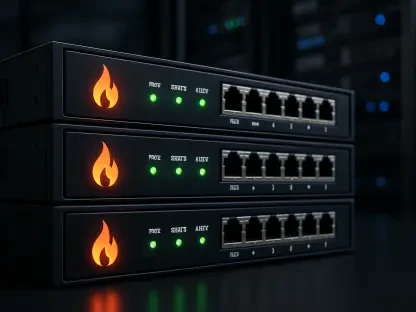In an era where enterprises are grappling with the soaring costs and security concerns of public cloud platforms, Oxide Computer Company has emerged as a beacon of innovation with a substantial $100 million Series B funding round, redefining on-premises infrastructure. Founded in 2019 by industry pioneers Steve Tuck, Bryan Cantrill, and Jessie Frazelle, this startup is delivering the agility and scalability of public cloud environments within the controlled confines of private networks. Their flagship product, a fully integrated cloud-computing rack, addresses a critical need for businesses looking to repatriate workloads from public clouds due to escalating expenses—often 2.5 times higher for large data volumes. With total capital now exceeding $189 million, thanks to lead investor Thomas Tull’s US Innovative Technology Fund and support from Eclipse Ventures and Intel Capital, Oxide is well-positioned to meet the growing demand for cost-effective, secure alternatives. This development signals a pivotal moment in the evolution of enterprise IT, where control and efficiency are becoming paramount.
The Drive Behind On-Premises Innovation
Addressing Cloud Repatriation
As public cloud adoption continues to dominate for smaller firms, larger enterprises are increasingly reevaluating their strategies due to mounting financial burdens and data sovereignty issues. The trend of repatriation—moving workloads back to on-premises environments—has gained significant traction, driven by the realization that public cloud costs can spiral out of control with high-volume data processing. Oxide steps into this space with a solution that promises the best of both worlds: the flexibility of cloud services without the hefty price tag or loss of control. Their cloud-computing rack is tailored for organizations seeking to maintain strict oversight over their data while still leveraging modern infrastructure capabilities. This shift reflects a broader industry awakening to the limitations of relying solely on hyperscale providers for all computing needs, positioning Oxide as a timely contender in addressing these pain points.
Beyond the financial incentives, repatriation is also fueled by a desire for enhanced security and compliance with regulatory demands. Enterprises handling sensitive information, particularly in sectors like finance and research, often find public cloud environments lacking in the granular control needed to meet stringent standards. Oxide’s on-premises solution offers a private, secure alternative that doesn’t sacrifice the programmability or scalability associated with cloud platforms. By integrating purpose-built hardware and software, the company ensures that businesses can operate within a fortified network while still accessing API-driven resources and elastic storage. This approach not only mitigates risks associated with data breaches but also aligns with the growing emphasis on data localization, making Oxide’s offering a strategic fit for organizations navigating complex global regulations.
Simplifying Complex Infrastructure
Traditional on-premises setups have long been plagued by the chaos of multivendor components, intricate licensing agreements, and integration challenges—a situation Oxide’s CTO Bryan Cantrill has famously dubbed a “kit-car disaster.” Oxide counters this frustration with a turnkey system that unifies hardware and software into a seamless cloud-computing rack. Designed from the ground up, the product eliminates the need to cobble together disparate solutions from various vendors, streamlining deployment and ongoing management. With compute sleds powered by AMD EPYC processors and custom switches based on Intel Tofino 2 ASICs, the rack delivers robust performance while minimizing operational headaches. This integrated design resonates strongly with IT teams tired of wrestling with compatibility issues and endless support tickets.
Moreover, Oxide’s focus on simplification extends to the user experience, ensuring that enterprises can replicate public cloud benefits like seamless updates and multitenancy without the complexity. The rack’s software suite—covering networking, hypervisor, and virtual storage—works in tandem with hardware innovations like optimized cooling and minimal cabling, creating an efficient datacenter footprint. This holistic approach contrasts sharply with the fragmented nature of traditional private infrastructure, where every update or expansion risks disrupting operations. By offering a cohesive system, Oxide not only reduces the technical burden on enterprises but also frees up resources for strategic initiatives, marking a significant departure from the cumbersome legacy systems that have long hindered on-premises adoption.
Competitive Positioning and Challenges
Facing Industry Giants
Navigating the cloud computing landscape, Oxide finds itself pitted against formidable adversaries, including hyperscale public cloud providers like AWS, Microsoft Azure, and Google Cloud, as well as entrenched hardware vendors such as Hewlett Packard Enterprise (HPE), Dell, and Supermicro. These industry giants boast vast resources, extensive customer bases, and decades of market presence, presenting a steep uphill battle for a startup like Oxide. However, the company differentiates itself through a singular focus on an all-in-one, fully integrated rack that avoids the multivendor pitfalls of competitors like HPE, whose private cloud offerings often rely on a mix of in-house and third-party components. This unique selling point—combining custom hardware and software—offers a compelling alternative for enterprises frustrated by integration complexities, though it must prove its scalability against well-established solutions.
The challenge for Oxide lies in carving out a sustainable niche amidst this crowded field, where brand loyalty and existing contracts often favor incumbents. Hyperscalers, with their vast ecosystems and near-infinite scalability, cater to businesses comfortable with outsourcing control, while hardware vendors provide modular flexibility that appeals to diverse IT environments. Oxide’s strategy hinges on convincing enterprises that its streamlined, on-premises elastic infrastructure can deliver comparable performance without the trade-offs of cost or dependency. Success will depend on demonstrating tangible benefits through real-world deployments and customer testimonials, as well as maintaining agility to adapt to rapidly evolving industry demands. The road ahead is daunting, but Oxide’s focused innovation provides a foundation to challenge the status quo if executed effectively.
Gaps in AI Capabilities
One critical area where Oxide’s proposition remains ambiguous is its support for AI workloads, a cornerstone of modern enterprise computing. As businesses increasingly prioritize artificial intelligence for tasks ranging from data analytics to customer engagement, infrastructure capable of handling intensive processing demands is non-negotiable. While Oxide’s rack boasts impressive specs with AMD EPYC processors and high-capacity custom switches, specifics about optimization for AI tasks like foundation model training or inferencing are notably absent. This lack of clarity could hinder its appeal to organizations investing heavily in AI-driven transformation, especially when competitors like HPE integrate NVIDIA GPUs and specialized software into their private cloud offerings to address these exact needs.
Despite this uncertainty, there is potential for Oxide to align with enterprise priorities, particularly in areas like inferencing, which often requires less computational intensity than training. Deployments with clients such as Lawrence Livermore National Laboratory and CoreWeave suggest that high-performance computing environments—potentially including AI workloads—are within reach. However, without explicit confirmation of tailored capabilities, Oxide risks ceding ground to rivals who have already staked claims in the AI infrastructure space. Addressing this gap will be crucial for maintaining competitive relevance, as the demand for AI-ready systems continues to accelerate across industries. The company’s ability to adapt or expand its roadmap to include such features could determine its long-term viability in a market increasingly shaped by intelligent automation.
Market Relevance and Future Growth
Early Customer Wins
Oxide’s initial foray into the market has yielded promising results, with deployments at high-profile entities like Lawrence Livermore National Laboratory, CoreWeave, and a prominent financial services firm. These early adopters span diverse sectors—research, cloud services, and finance—highlighting the versatility of Oxide’s cloud-computing rack in addressing varied enterprise needs. For institutions handling sensitive or massive datasets, the appeal lies in the ability to maintain on-premises control while accessing cloud-like programmability and scalability. Such partnerships validate Oxide’s relevance in environments demanding high-performance computing, offering a glimpse into its potential to serve as a backbone for critical operations across industries with stringent requirements.
Furthermore, these customer wins underscore Oxide’s strategic focus on larger organizations rather than smaller businesses, aligning with the repatriation trend among enterprises managing substantial data volumes. The diversity of its early client base also suggests adaptability to unique workloads, whether supporting cutting-edge research or powering financial transactions. This broad applicability enhances Oxide’s market positioning, providing a foundation to build trust and credibility among prospective customers. As more enterprises witness the tangible benefits of Oxide’s solution through these real-world applications, the company could see accelerated adoption, provided it maintains momentum in delivering consistent value and support to its growing user base.
Funding for Scale
The recent $100 million Series B funding round, bringing Oxide’s total capital to over $189 million, represents a significant vote of confidence from investors like Thomas Tull’s US Innovative Technology Fund and returning backers Eclipse Ventures and Intel Capital. This financial infusion is earmarked for critical areas such as scaling manufacturing capacity, bolstering customer support, and executing an ambitious product roadmap to meet rising demand for on-premises solutions. With enterprises increasingly seeking alternatives to public cloud dependency, Oxide is poised to capitalize on this market shift by ensuring its infrastructure can be produced and deployed at scale, addressing the logistical challenges that often accompany rapid growth in the hardware sector.
Equally important is the emphasis on enhancing customer support, a vital component for maintaining satisfaction among enterprise clients with complex needs. The funding will enable Oxide to build a robust support framework, ensuring seamless implementation and ongoing maintenance of its cloud racks. Additionally, investment in roadmap execution signals a commitment to continuous innovation, potentially addressing current limitations and expanding capabilities to stay competitive. This financial backing not only fuels operational expansion but also reinforces investor belief in Oxide’s vision to redefine on-premises infrastructure. As the company leverages these resources, its ability to deliver on promises will shape its trajectory in a dynamic and demanding market.
Charting the Path Forward
Reflecting on Oxide Computer Company’s journey, the $100 million Series B funding round marked a defining chapter in its mission to transform enterprise IT with on-premises cloud solutions. The company’s integrated rack design tackled longstanding frustrations with multivendor complexity and public cloud costs, offering a fresh perspective on private infrastructure. Early partnerships with leading organizations validated its approach, while investor support underscored market confidence. Yet, challenges loomed large against industry titans and unanswered questions about AI readiness. Moving forward, Oxide must prioritize expanding its technological capabilities, particularly in high-growth areas like artificial intelligence, to solidify its standing. Strengthening customer relationships through superior support and iterating on product innovation will be essential steps. As the repatriation trend continued to reshape cloud computing dynamics, Oxide’s focus on delivering secure, scalable solutions positioned it to influence the future of how enterprises managed their digital ecosystems.









